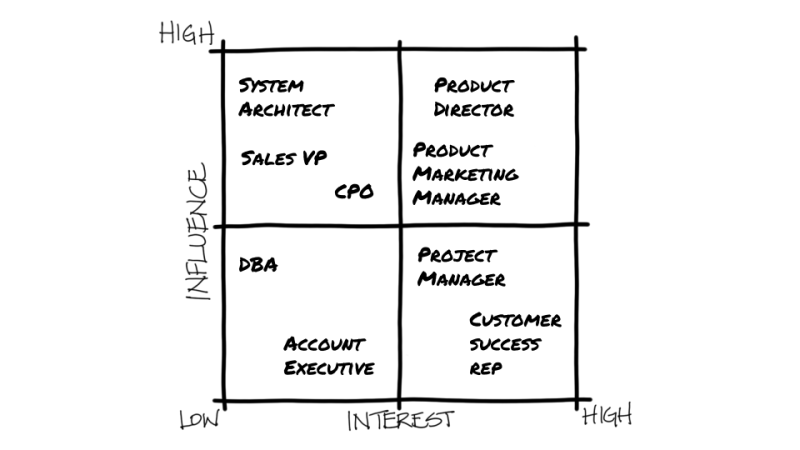Effective Stakeholder Management in Enterprise Product Development

Product development is a team sport. To build a successful product, you need to work closely with your entire product team - the product people, developers, and designers who work together to understand the problem you’re solving and design and build your solution.
You also have to work with people outside your product team to build, market, sell, and support your product. Those people are your stakeholders. In an enterprise setting, that group can be quite large.
Working with your stakeholders is often referred to as stakeholder management. But it’s important to realize that you’re not directly “managing” your stakeholders, you're managing your relationship with them.
Here's a look at what you need to do to effectively manage your relationship with your stakeholders in enterprise product development.
Why you should care about stakeholders
A stakeholder is a person or group that influences the fortunes of the product or is impacted by the product and who is not a customer, user, or member of the product team. It's “everyone else” who has a relationship with your product.
Stakeholders pose an interesting challenge for product teams. You need their help to build, market, sell, and support your product. And your product is not the only thing they are concerned about. That means you may not have their full attention when you need it, or they may have different objectives and incentives that guide their decisions.
Stakeholders can have considerable influence over your product and don’t have as close a connection to it as your product team. So you need to identify key stakeholders and then manage your relationships with them through how you communicate and set expectations.

How to identify key stakeholders
To identify key stakeholders, think through the people who will help you take your product to market, sell it, and support it.
From an enterprise product standpoint, assuming that your org is sales led, you’ll usually work with the following stakeholders:
Sales
Marketing
Customer success
Implementation teams
Company leadership
As your company grows, so does that chance you need help outside of your product team to build your product.
There are other product teams and technology staff you need help from to fully build the product. To identify those people and teams, use a context diagram to build an understanding of data flows in and out of your product.
Once you know who your stakeholders are, it’s helpful to determine their relationship to your product in terms of interest and impact.
You can chart that information on a Stakeholder Map in order to gain insight into how to interact with them. Here’s an example.

Keep in mind that stakeholders may have different levels of interest and impact at your company.
Doris Joyce, co-founder of Electrly has found that the key to identifying key stakeholders is “understanding your product, its main features, and who it affects. This practice allows you to pinpoint your stakeholders by gauging who will need your product and who creates and adds value to it.”
Denise Hemke, Chief Product Officer at Checkr reminds you to identify key stakeholders before anything else begins.
These folks can vary depending on the product, industry, and niche. Sometimes it's the executive team and sales—other times the key stakeholders are in marketing or customer service. You may even work to appease a regulatory body or influencers in your industry.
The last thing you want is unbidden, unwarranted advice that the stakeholders feel obligated to provide, since you asked them to take part. There's always time to add more people to a project—slimming the audience down to those who matter most is harder. Be selective when you're choosing stakeholders to work with. Make sure they're directly tied to your mission statement and actually have insights you'd seek elsewhere, if they weren't on the project.

How to communicate with stakeholders
After you’ve identified your key stakeholders and determined their level of interest and influence, you can then determine the best ways to communicate with each of them.
Using the stakeholder map, establish plans for communicating with each stakeholder based on where they land.
Low influence/Low interest—Monitor
These stakeholders (the DBA and Account Executive in our example) are usually only partially impacted by the solution.
You can usually point these stakeholders to general information about your product and let them decide if they’ll take advantage of it.
That said, monitor these stakeholders to make sure that their interest or influence doesn’t change during your product life cycle.
The DBA may not have much influence on your product until you need them to create, or restore a database for it. Likewise, the account executive is going to become a lot more interested in your product if she’s suddenly motivated to sell it in the next quarter.
Low influence/High interest—Keep informed
These stakeholders are an excellent source of detailed information about your project, so it’s important to understand their needs and solicit their input.
Keep up to speed about their perspective on your product. If they feel their concerns are not being addressed, they may engage more influential people.
In the example, the project manager is interested in your product because she’s responsible for implementing it for new customers. The customer success rep fits in this category because he’s responsible for helping customers when they have issues with your product.
They both provide additional insight into customers and user’s experience with your product so they can be a substantial source of feedback about your product.

High influence/Low interest—Keep satisfied
This group usually contains people with an important position in the organization who are not directly related to your product.
In the example above, the system architect, Sales VP and CPO fit into this quadrant because even though they are not directly involved with the project, they can exert a great deal of influence on it.
Your team should engage with stakeholders in this group to understand and satisfy their needs when they are in alignment with your outcome.
It also often pays to consult with these stakeholders on critical issues, but not for every single decision. You may also consider whether the product would benefit from having these stakeholders be more interested.
High influence/High interest—Manage closely
Fully engage any stakeholders who fall into this category, which usually includes sponsors and highly influential subject matter experts.
For the example above, include the product marketing manager as part of your product team, as they’ll be a critical part of taking your product to market.
As for the product director (who is most likely your boss), keep them up to date regularly and make sure there are no surprises about your product.

As you build out your plans to communicate with your stakeholders, there is some general guidance that applies regardless of how interested and influential they are.
Riley Adams, founder and CEO of Young and the Invested, suggests that "product managers have a challenging task, often compared to herding cats. They've got to wrangle several disparate teams to come together for one common purpose. That takes several important qualities to manage properly, the most important among them being: clarity, brevity, and consistency.”
Ryan Mckenzie, Co-Founder & CMO of Tru Earth, explains you need to tailor your message to resonate with them, focusing on how your product addresses their specific concerns. "Regular, transparent communication, such as sharing product updates, plans, and challenges faced, helps build mutual trust."
How to set stakeholder expectations
An important outcome of effective communication with your stakeholders is setting their expectations about what your product is and isn't.
Abhishek Shah, Founder of Testlify provides these detailed steps on how he sets proper expectations with his stakeholders.
Early engagement
We involve stakeholders from the project's early stages to gain a thorough understanding of their expectations and align them with project goals. By engaging stakeholders early on, we can address any potential misunderstandings or discrepancies promptly.
Clear scope definition
We establish a well-defined scope, outlining project objectives, deliverables, timelines, and potential limitations. This clarity helps manage stakeholders' expectations by providing a realistic view of what you can achieve within the given constraints.
Continuous feedback loop
We maintain an open feedback loop throughout the project lifecycle, encouraging stakeholders to provide feedback, voice concerns, and suggest adjustments. This iterative approach allows us to make necessary course corrections and ensure expectations remain aligned as the project progresses.
In order to follow the steps above successfully, a healthy dose of empathy will go a long way. When you can see things from the perspective of sales, customer success, marketing and your other stakeholders you’ll be in a much better position to set proper expectations.

Tools to help you work with stakeholders
As you build out your plans for working with stakeholders, you’ll want to find some tools to make those interactions as effective as possible. Fortunately, airfocus is particularly well suited for engaging stakeholders.
You can use airfocus to create a branded portal to share your roadmaps, plans, and releases.
When you get feedback from sharing that information, use airfocus’ feedback management tool Insights to identify actionable insights that inform discovery and product strategy.
And when you want input from stakeholders to reach consensus on product priorities, you can use Priority Poker to help facilitate those discussions.

Kent McDonald

Read also

All product feedback in one place

Experience the new way of doing product management




